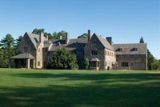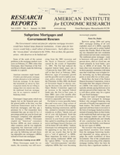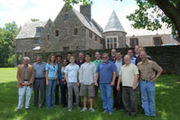
American Institute for Economic Research
Encyclopedia
American Institute for Economic Research (AIER), located in Great Barrington, Massachusetts
, is one of the oldest economic research organizations in the United States. Founded in 1933, AIER is an independent 501(c)(3) organization that, according to its website, represents no fund, concentration of wealth, or other special interests. AIER conducts research and publishes books and periodical on a wide array of economic issues, including personal finances, business cycles, monetary policy and property rights.
“For over 70 years, the American Institute for Economic Research has done a highly credible job tracking U.S. Business cycles.”
–Archie Richards, "Money Matters” columnist
The provisions of the charter and bylaws ensure that neither the Institute itself nor members of its staff may derive profit from organizations or businesses that happen to benefit from the results of Institute research. Institute financial accounts are available for public inspection during normal working hours of the Institute.
By 1934, the magnitude of the Great Depression suggested the need for a research organization to inquire into the wide range of economic, social, and monetary developments that had contributed to the catastrophic economic contraction. The hope was that by further developing and applying modern scientific procedures of inquiry, results could be obtained that would be useful to the Nation in avoiding a repetition of the disaster. On the advice of Dr. Vannevar Bush, then vice-president of the Massachusetts Institute of Technology, Col. E. C. Harwood founded American Institute for Economic Research (AIER) to conduct the necessary research.
“Straight-shooting …”
–Fredericksburg Free-Lance Star, CA
Initially AIER was housed in the office of a staff member at the Massachusetts Institute of Technology, but soon expansion required more space. For several years the Institute occupied buildings in Cambridge, Massachusetts that it also soon outgrew.
At the end of the Second World War, Col. E. C. Harwood and Helen Harwood investigated the potential of several "white elephants" in Berkshire County, Massachusetts as a new home for AIER. After successful negotiations, they moved operations to Great Barrington. After several months of preparing the new location, AIER resumed full operation at its new location with plenty of room for future expansion.
"The American Institute for Economic Research is a leading economic forecasting firm."
–Donald Lambro, Washington Times columnist
 On the advice of Dr. Vannevar Bush
On the advice of Dr. Vannevar Bush
, then vice-president and dean of engineering at Massachusetts Institute of Technology
, Col. Edward C. Harwood
founded AIER to conduct research into the wide range of economic, social, and monetary developments that had contributed to the catastrophic economic contraction of the Great Depression.
Harwood, a graduate of the United States Military Academy, was serving in the Army Corps of Engineers in the 1920s when he undertook an intensive study of economics, with particular emphasis on money-credit problems. Bush's support for Harwood was based on articles that Harwood has published in financial journals in 1928 and 1929 that accurately predicted the impending depression.
AIER was housed initially in an office at the Massachusetts Institute of Technology
, then moved to Cambridge, Massachusetts
. At the end of World War II, Harwood relocated to a "white elephant" manor house in Great Barrington. In 1956-57, a printshop annex and warehouse were added, and in 1962 a research library was added to the hillside below the annex. Now known as the E. C. Harwood Library, the 10000 square feet (929 m²) building contains AIER's principal offices.
 AIER has two regular periodical publication
AIER has two regular periodical publication
s, the twice-monthly Research Reports and the monthly Economic Education Bulletin. The Institute also publishes a number of books, including the best-selling How To Avoid Financial Tangles, which was first published in 1938.
Research Reports offers twenty-two newsletters, in either digital or print format, that provide a concise discussion of a wide range of current issues including taxes, Social Security, rising inflation, the cost of living, insurance, financial fraud, and much more. One article each month is devoted to showing changes in economic activity.
Economic Education Bulletin consists of twelve monthly publications, which vary in length from four pages to book-length studies, providing a more in-depth treatment of issues pertaining to economics and personal finance.
Recent book length studies include: The Constitutional Protection of Property Rights (2008), The Global Warming Debate: Science, Economics, and Policy (2008), How to Plan for Your Retirement Years (2007 update), How to Invest Wisely (2007 update), How to Avoid Financial Fraud (2004), If Something Should Happen (2008) and How to Avoid Financial Tangles (2007 update).
 AIER offers a Summer Fellowship Program where Graduate Student Fellows and Research Fellows live and study together on AIER's campus to gain a unique, objective perspective into economic, monetary, and social issues. Prominent economists such as Anna J. Schwartz
AIER offers a Summer Fellowship Program where Graduate Student Fellows and Research Fellows live and study together on AIER's campus to gain a unique, objective perspective into economic, monetary, and social issues. Prominent economists such as Anna J. Schwartz
regularly participate in AIER's programs. Participants apply a historical, institutional, and methodological focus to economics, distinct from traditional undergraduate and graduate instruction.
Student Fellows receive a weekly stipend, room and board. Qualified students may apply for graduate school in absentia financial support; average fellowship awards may exceed $5,000. During four weeks in residence, Student Fellows participate in intensive seminars on property rights, scientific procedures of inquiry, sound money, and other topics. Assigned readings in these areas provide the basis for written assignments and seminar discussions. Seminar sessions are not conducted as formal lectures, but rather are structured to encourage a disciplined exchange of views.
Visiting Research Fellows receive a stipend, housing, office space and access to AIER's extensive research library. Fields of research typically include money, banking and credit; public and personal finance; economic and monetary history; the role of government in society; the methodology of economics; and the role of individual freedom, private property, and free enterprise in economic progress.
Great Barrington, Massachusetts
Great Barrington is a town in Berkshire County, Massachusetts, United States. It is part of the Pittsfield, Massachusetts Metropolitan Statistical Area. The population was 7,104 at the 2010 census. Both a summer resort and home to Ski Butternut, Great Barrington includes the villages of Van...
, is one of the oldest economic research organizations in the United States. Founded in 1933, AIER is an independent 501(c)(3) organization that, according to its website, represents no fund, concentration of wealth, or other special interests. AIER conducts research and publishes books and periodical on a wide array of economic issues, including personal finances, business cycles, monetary policy and property rights.
Mission
The mission of AIER is to conduct independent, scientific, economic research to educate individuals, thereby advancing their personal interests and those of the nation.“For over 70 years, the American Institute for Economic Research has done a highly credible job tracking U.S. Business cycles.”
–Archie Richards, "Money Matters” columnist
The provisions of the charter and bylaws ensure that neither the Institute itself nor members of its staff may derive profit from organizations or businesses that happen to benefit from the results of Institute research. Institute financial accounts are available for public inspection during normal working hours of the Institute.
By 1934, the magnitude of the Great Depression suggested the need for a research organization to inquire into the wide range of economic, social, and monetary developments that had contributed to the catastrophic economic contraction. The hope was that by further developing and applying modern scientific procedures of inquiry, results could be obtained that would be useful to the Nation in avoiding a repetition of the disaster. On the advice of Dr. Vannevar Bush, then vice-president of the Massachusetts Institute of Technology, Col. E. C. Harwood founded American Institute for Economic Research (AIER) to conduct the necessary research.
“Straight-shooting …”
–Fredericksburg Free-Lance Star, CA
Initially AIER was housed in the office of a staff member at the Massachusetts Institute of Technology, but soon expansion required more space. For several years the Institute occupied buildings in Cambridge, Massachusetts that it also soon outgrew.
At the end of the Second World War, Col. E. C. Harwood and Helen Harwood investigated the potential of several "white elephants" in Berkshire County, Massachusetts as a new home for AIER. After successful negotiations, they moved operations to Great Barrington. After several months of preparing the new location, AIER resumed full operation at its new location with plenty of room for future expansion.
"The American Institute for Economic Research is a leading economic forecasting firm."
–Donald Lambro, Washington Times columnist
History

Vannevar Bush
Vannevar Bush was an American engineer and science administrator known for his work on analog computing, his political role in the development of the atomic bomb as a primary organizer of the Manhattan Project, the founding of Raytheon, and the idea of the memex, an adjustable microfilm viewer...
, then vice-president and dean of engineering at Massachusetts Institute of Technology
Massachusetts Institute of Technology
The Massachusetts Institute of Technology is a private research university located in Cambridge, Massachusetts. MIT has five schools and one college, containing a total of 32 academic departments, with a strong emphasis on scientific and technological education and research.Founded in 1861 in...
, Col. Edward C. Harwood
Edward C. Harwood
Edward C. Harwood was a 20th century economist, philosopher of science, and investment advisor who is most known for founding the nonprofit American Institute for Economic Research in 1933, which entity survives today in Great Barrington, Massachusetts. AIER is a scientific research organization...
founded AIER to conduct research into the wide range of economic, social, and monetary developments that had contributed to the catastrophic economic contraction of the Great Depression.
Harwood, a graduate of the United States Military Academy, was serving in the Army Corps of Engineers in the 1920s when he undertook an intensive study of economics, with particular emphasis on money-credit problems. Bush's support for Harwood was based on articles that Harwood has published in financial journals in 1928 and 1929 that accurately predicted the impending depression.
AIER was housed initially in an office at the Massachusetts Institute of Technology
Massachusetts Institute of Technology
The Massachusetts Institute of Technology is a private research university located in Cambridge, Massachusetts. MIT has five schools and one college, containing a total of 32 academic departments, with a strong emphasis on scientific and technological education and research.Founded in 1861 in...
, then moved to Cambridge, Massachusetts
Cambridge, Massachusetts
Cambridge is a city in Middlesex County, Massachusetts, United States, in the Greater Boston area. It was named in honor of the University of Cambridge in England, an important center of the Puritan theology embraced by the town's founders. Cambridge is home to two of the world's most prominent...
. At the end of World War II, Harwood relocated to a "white elephant" manor house in Great Barrington. In 1956-57, a printshop annex and warehouse were added, and in 1962 a research library was added to the hillside below the annex. Now known as the E. C. Harwood Library, the 10000 square feet (929 m²) building contains AIER's principal offices.
Publications

Periodical publication
Periodical literature is a published work that appears in a new edition on a regular schedule. The most familiar examples are the newspaper, often published daily, or weekly; or the magazine, typically published weekly, monthly or as a quarterly...
s, the twice-monthly Research Reports and the monthly Economic Education Bulletin. The Institute also publishes a number of books, including the best-selling How To Avoid Financial Tangles, which was first published in 1938.
Research Reports offers twenty-two newsletters, in either digital or print format, that provide a concise discussion of a wide range of current issues including taxes, Social Security, rising inflation, the cost of living, insurance, financial fraud, and much more. One article each month is devoted to showing changes in economic activity.
Economic Education Bulletin consists of twelve monthly publications, which vary in length from four pages to book-length studies, providing a more in-depth treatment of issues pertaining to economics and personal finance.
Recent book length studies include: The Constitutional Protection of Property Rights (2008), The Global Warming Debate: Science, Economics, and Policy (2008), How to Plan for Your Retirement Years (2007 update), How to Invest Wisely (2007 update), How to Avoid Financial Fraud (2004), If Something Should Happen (2008) and How to Avoid Financial Tangles (2007 update).
Summer Fellowship

Anna Schwartz
Anna Jacobson Schwartz is an economist at the National Bureau of Economic Research in New York City, and according to Paul Krugman "one of the world's greatest monetary scholars"...
regularly participate in AIER's programs. Participants apply a historical, institutional, and methodological focus to economics, distinct from traditional undergraduate and graduate instruction.
Student Fellows receive a weekly stipend, room and board. Qualified students may apply for graduate school in absentia financial support; average fellowship awards may exceed $5,000. During four weeks in residence, Student Fellows participate in intensive seminars on property rights, scientific procedures of inquiry, sound money, and other topics. Assigned readings in these areas provide the basis for written assignments and seminar discussions. Seminar sessions are not conducted as formal lectures, but rather are structured to encourage a disciplined exchange of views.
Visiting Research Fellows receive a stipend, housing, office space and access to AIER's extensive research library. Fields of research typically include money, banking and credit; public and personal finance; economic and monetary history; the role of government in society; the methodology of economics; and the role of individual freedom, private property, and free enterprise in economic progress.

